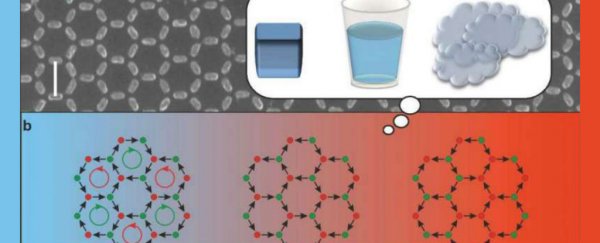A synthetic material made from 1 billion nanomagnets has displayed the rare ability to change states when exposed to temperature fluctuations. Just like water has a gaseous, liquid, and solid state, this magnet material displays physical phase transitions when gradually cooled right down to almost freezing.
"We were surprised and excited," lead researcher behind the new material, Laura Heyderman from the Paul Scherrer Institute in Switzerland, said in a press release. "Only complex systems are able to display phase transitions."
Classified as a metamaterial because it displays properties that have yet to be found in nature, the complex nanomagnet structure has the potential to provide new methods of information transfer and memory storage, the team suggests.
Each magnet is just 63 nanometres long (1 nm = 10-6 millimetres) and shaped sort of like a grain of rice. One million of these were arranged together on a flat substrate, and they formed a tight honeycomb pattern, covering an area of 5 x 5 mm.
The team first observed the behaviour of these magnets at room temperature and found that their orientation was completely random - there was no rhyme or reason to where the magnets' north and south poles were pointing. The team calls this a "highly degenerate spin ice phase (Ice I)".
But then they started to slowly cool the material down, and soon enough, the magnets started interacting with each other, and their orientation showed signs of being influenced by neighbouring magnets. This is classified as the "charge-ordered phase (Ice II)". Cooled down even further, and the magnetic arrangement appeared to undergo another change - it was almost frozen, just like water. They call this the "long-range charge- and spin-ordered (LRO) phase".
"We were fascinated by the fact that our synthetic material displayed this everyday phenomenon of a phase transition," says Heyderman.
A major advantage to this material is that while the complex atomic structures of natural materials are impossible to rearrange with extreme precision on a large scale, because this one is made entirely of magnets, it can be customised very easily. This will allow the researchers to not only alter the shape and size of the magnets in future iterations of the material, but also their arrangement in the honeycomb structure, so they can investigate the possibility of new states of matter.
"The beauty of it all: tailored phase transitions could enable metamaterials to be adapted specifically for different needs in future," says Heyderman.
The hope is that a material like this could have future applications in both data transfer and data storage. As researchers working on a different type of magnetic device explained earlier this year, the state at which the magnets are weakly interacting can be used as memory to store information 'bits', while the high-energy state where the magnets are strongly interacting with their neighbours allows for the movement of information through quantum dynamics. Another possible application is in sensors that measure magnetic fields.
The results have been published in Nature Communications.
